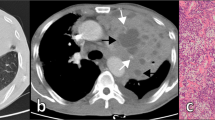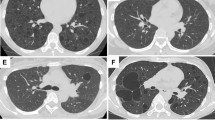Abstract
Computed tomographic scanning of the chest in 100 patients with newly diagnosed malignant lymphoma detected mediastinal lymphadenopathy (39%) and parenchymal deposits (15%) with a significantly greater sensitivity and specificity than conventional radiological techniques. This principally affected the staging and treatment of patients with limited stage disease. The stage was changed in 10/61 patients (16%) with Stages I-III prior to CT scan and treatment was altered in 11/29 (38%) patients for whom radiation was the treatment of choice. Complete remissions as defined by CT scan have been more durable than those defined by CXR alone.
This is a preview of subscription content, access via your institution
Access options
Subscribe to this journal
Receive 24 print issues and online access
$259.00 per year
only $10.79 per issue
Buy this article
- Purchase on Springer Link
- Instant access to full article PDF
Prices may be subject to local taxes which are calculated during checkout
Similar content being viewed by others
Rights and permissions
About this article
Cite this article
Gallagher, C., White, F., Tucker, A. et al. The role of computed tomography in the detection of intrathoracic lymphoma. Br J Cancer 49, 621–629 (1984). https://doi.org/10.1038/bjc.1984.97
Issue Date:
DOI: https://doi.org/10.1038/bjc.1984.97
This article is cited by
-
Computerised tomography in the staging of Hodgkin's disease and non-Hodgkin's lymphoma
European Journal of Nuclear Medicine and Molecular Imaging (2003)



